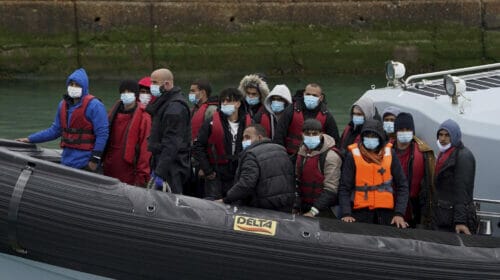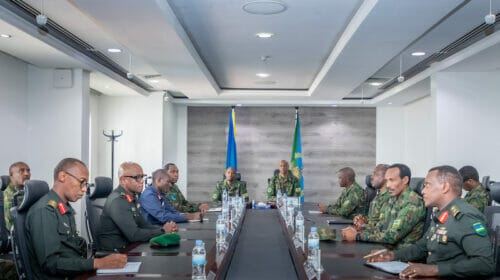DR Congo faces food insecurity despite aid
In war-torn Democratic Republic of Congo, aid is not turning into food security – leaving populations close to famine. |
|
|
Bureaucracy can lead to food sitting in warehouses while local communities face hunger [Molly McCluskey/Al Jazeera]
|
|
| Goma, Democratic Republic of Congo – When the World Food Programme delivered aid to internally displaced people in the camps nearest to Goma, it did so after several months of warnings that funding shortages could lead to famine conditions.
Months had passed since the last delivery of aid to the camps. During that time, food had run out at the Mugunga Internally Displaced Persons (IDP) camp, and residents spoke in April of an increase in prostitution and theft as a result of the insecure conditions. “There is no food,” said a woman named Mary, as she braided another woman’s hair in Mugunga’s makeshift beauty salon consisting of a single, broken plastic chair. “We don’t know if there will ever be food again.” But there was food. Nearby, a WFP warehouse held 2,200 tonnes. Some of it, including bags of rice and corn, was stamped with expiry dates from nearly a year prior. It seems like a clear problem with an easy solution – people are starving, and relief organisations have food. But the issue of aid in the Democratic Republic of Congo (DRC) is mired by social, political and economic stakes in a region that has faced two decades of fighting. According to Dr J Peter Pham, director of the Africa Center at the Atlantic Council in Washington, DC, the challenge of food insecurity in the Congo is not climatological or meteorological, unlike other African nations in crisis. The weather and soil conditions are ripe for planting, but the political conditions are not. “It’s not just a matter of forcing people, or incentivising them, to go home and plant. You have to really create the conditions where it would make sense for them to do so,” Pham said. “If I’m a Congolese, I’m not going to plant, hoe, weed and do all that back-breaking work for the next six months if I have a reasonable fear that in three months I might be running for my life – or if I’m not running, that a marauding gang, or for that matter, marauding government troops, are likely to eat my crop for me.” A pattern of dependency This creates tensions between releasing the food aid into the community, which will flood the market and drive down costs, and keeping the market restricted enough to inflate prices to encourage people to attempt farming. “Holding the food back means there are people hungry now,” Pham said. “But releasing it would mean a likelihood of even greater hunger down the road.” According to Julien Paluku Kahongya, governor of North Kivu province, this lack of security has created a pattern of dependency on the international humanitarian aid community, and on the government, that is proving difficult to break. “When the war ended, we told people to leave the camps and go back to their villages,” he told Al Jazeera from a table on his front lawn while gunfire rang out nearby. “Now, we see there is a population that wants to stay in camps forever and demand assistance. That is why you can see aid remaining in our warehouses. It is not because we want the population to die with hunger, but because we want to be sure that the IDPs who are in front of us are real IDPs.” Kahongya said he is partnering with the NGOs to complete a new census of those still in the camps. Further restrictions on how aid can be distributed, determined by foreign donors, can also thwart the relief process. In his office at the WFP compound in Goma, an employee pulls a distribution request from an old filing cabinet. “Each month, they send me a distribution plan,” he said, referring to WFP headquarters in the DRC. “This one asks for cooking oil. At the moment, I have around 300 tonnes of oil in the warehouse.” But the US donation has some restrictions, he explained: “It’s only for IDPs. But this request is for food-for-work – so I cannot send the oil.” He asked not to be named to prevent possible repercussions from speaking to the press. Oil, rice, corn and the tonnes of food at the WFP warehouses sit until the right paperwork, hunger levels and economic conditions determine when it should be distributed. ‘What kind of country have we become?’ The continued presence of international aid organisations is a point of ambivalence for some locals, who increasingly view the patrons with wariness. More than 15 people interviewed for this article – including international and local aid workers, business owners, and government employees, among others – questioned the ongoing relief culture that has pervaded Goma, and whether the local economy would collapse should the international community leave the region. “There is no exit strategy,” said Fidel Bafilemba, a Goma-based field researcher with Enough, an NGO devoted to ending genocide and other crimes against humanity, and a former international aid worker. “There is no plan for allowing Congo to sustain itself. What kind of country have we become knowingmuzungas [Westerners] provide all our basic needs – food, water, shelter? What will happen when they leave?”
As Bafilemba spoke, several UN helicopters roared overhead. He pointed to the sky and said, “We hope that will be the UN legacy; that they will leave their trucks and their buildings and their helicopters here when they go.” That exit doesn’t appear to be forthcoming. After nearly 20 years of “emergency relief”, the international aid community is woven into the fabric of Goma, so it’s difficult to tell where one ends and the other begins. There is no comprehensive, collaborative plan between the agencies, no review of which programmes have been successful and which haven’t, or what work is still needed. One high-ranking UN official, speaking on condition of anonymity because her views do not reflect that of the organisation’s, said: “We cannot keep injecting this money. Some of the relief has to come from the government. Maybe they have the means, but are they willing? If the crisis had just started, maybe it would be understandable, but it’s been 20 years. They need to think about how things will work.” But if the displaced have become dependent on international aid organisations for sustenance, those groups are equally dependent on the people they support. “Without the picture of the starving child or the near famine or potential famine to grab headlines, aid organisations have a fundraising issue,” Pham said. “In the long history of international aid agencies, there are very few that seek to put themselves out of business.” Eunice Smith, head of Logistics for the World Food Programme in Goma, said the WFP and other aid organisations will remain in the DRC as long as they are needed. Smith refused to speculate on how long that might be. “The IDPs now expect to receive aid. It’s why we’re here,” she said. “As long as there is insecurity, there is business for us.” The World Food Programme expects to make another delivery to Goma-area camps in May. The organisation said it needs to raise $40m by October 2014 to continue its food-relief operations in the DRC. Reporting from the DRC was made possible through a fellowship with the International Women’s Media Foundation. |



